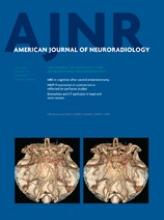Index by author
Jensen, J.H.
- EDITOR'S CHOICEBrainOpen AccessCognitive Impairment in Mild Traumatic Brain Injury: A Longitudinal Diffusional Kurtosis and Perfusion Imaging StudyE.J. Grossman, J.H. Jensen, J.S. Babb, Q. Chen, A. Tabesh, E. Fieremans, D. Xia, M. Inglese and R.I. GrossmanAmerican Journal of Neuroradiology May 2013, 34 (5) 951-957; DOI: https://doi.org/10.3174/ajnr.A3358
DTI, diffusional kurtosis, and arterial spin-labeling were used in an attempt to detect abnormalities in 20 patients shortly after mild traumatic brain injury. These patients were also evaluated for attention, concentration, executive functioning, memory, learning, and information processing. At 1 and 9 months after injury, all patients showed significant abnormalities in gray and white matter by using all techniques and thus these methods may be useful in investigating cognitive impairment after brain injury.
Kallmes, D.F.
- NeurointerventionYou have accessInterobserver Variability in Retreatment Decisions of Recurrent and Residual AneurysmsJ.S. McDonald, R.E. Carter, K.F. Layton, J. Mocco, J.B. Madigan, R.G. Tawk, R.A. Hanel, S.S. Roy, H.J. Cloft, A.M. Klunder, S.H. Suh and D.F. KallmesAmerican Journal of Neuroradiology May 2013, 34 (5) 1035-1039; DOI: https://doi.org/10.3174/ajnr.A3326
- NeurointerventionYou have accessAge-Related Trends in the Treatment and Outcomes of Ruptured Cerebral Aneurysms: A Study of the Nationwide Inpatient Sample 2001–2009W. Brinjikji, G. Lanzino, A.A. Rabinstein, D.F. Kallmes and H.J. CloftAmerican Journal of Neuroradiology May 2013, 34 (5) 1022-1027; DOI: https://doi.org/10.3174/ajnr.A3321
Kerl, J.M.
- Head and Neck ImagingYou have accessPerformance of Iterative Image Reconstruction in CT of the Paranasal Sinuses: A Phantom StudyB. Schulz, M. Beeres, B. Bodelle, R. Bauer, F. Al-Butmeh, A. Thalhammer, T.J. Vogl and J.M. KerlAmerican Journal of Neuroradiology May 2013, 34 (5) 1072-1076; DOI: https://doi.org/10.3174/ajnr.A3339
Kesari, S.
- BrainOpen AccessImproved Conspicuity and Delineation of High-Grade Primary and Metastatic Brain Tumors Using “Restriction Spectrum Imaging”: Quantitative Comparison with High B-Value DWI and ADCN.S. White, C.R. McDonald, N. Farid, J.M. Kuperman, S. Kesari and A.M. DaleAmerican Journal of Neuroradiology May 2013, 34 (5) 958-964; DOI: https://doi.org/10.3174/ajnr.A3327
Kitajima, M.
- BrainYou have accessPrevalence and Topography of Small Hypointense Foci Suggesting Microbleeds on 3T Susceptibility-Weighted Imaging in Various Types of DementiaH. Uetani, T. Hirai, M. Hashimoto, M. Ikeda, M. Kitajima, F. Sakamoto, D. Utsunomiya, S. Oda, S. Sugiyama, J. Matsubara and Y. YamashitaAmerican Journal of Neuroradiology May 2013, 34 (5) 984-989; DOI: https://doi.org/10.3174/ajnr.A3332
Klunder, A.M.
- NeurointerventionYou have accessInterobserver Variability in Retreatment Decisions of Recurrent and Residual AneurysmsJ.S. McDonald, R.E. Carter, K.F. Layton, J. Mocco, J.B. Madigan, R.G. Tawk, R.A. Hanel, S.S. Roy, H.J. Cloft, A.M. Klunder, S.H. Suh and D.F. KallmesAmerican Journal of Neuroradiology May 2013, 34 (5) 1035-1039; DOI: https://doi.org/10.3174/ajnr.A3326
Kobayashi, M.
- EDITOR'S CHOICEBrainOpen AccessPostoperative Changes in Cerebral Metabolites Associated with Cognitive Improvement and Impairment after Carotid Endarterectomy: A 3T Proton MR Spectroscopy StudyH. Saito, K. Ogasawara, H. Nishimoto, Y. Yoshioka, T. Murakami, S. Fujiwara, M. Sasaki, M. Kobayashi, K. Yoshida, Y. Kubo, T. Beppu and A. OgawaAmerican Journal of Neuroradiology May 2013, 34 (5) 976-982; DOI: https://doi.org/10.3174/ajnr.A3344
This study assessed the use of metabolites seen on MRS as markers of change in cognitive status after carotid artery surgery. MRS and neurocognitive testing were obtained before and after surgery in 100 patients. The results showed that cognition remained unchanged in 80%, improved in 10%, and was impaired in 10% of patients postoperatively and that in these last 2 groups, NAA/Cr correlated well the clinical status. Thus, NAA/Cr may serve as a marker of neurologic status after carotid artery surgery (see accompanying editorial by Lövblad and Pereira).
Koch, B.
- Technical NoteOpen AccessQuantitative Assessment of Chronic Thalamic StrokeG. Pergola, B. Suchan, B. Koch, M. Schwarz, I. Daum and O. GüntürkünAmerican Journal of Neuroradiology May 2013, 34 (5) E51-E55; DOI: https://doi.org/10.3174/ajnr.A2897
Koculym, A.
- BrainYou have accessCT Perfusion Spot Sign Improves Sensitivity for Prediction of Outcome Compared with CTA and Postcontrast CTA. Koculym, T.J. Huynh, R. Jakubovic, L. Zhang and R.I. AvivAmerican Journal of Neuroradiology May 2013, 34 (5) 965-970; DOI: https://doi.org/10.3174/ajnr.A3338
Krings, T.
- FELLOWS' JOURNAL CLUBNeurointerventionYou have accessAngioarchitecture of Brain AVM Determines the Presentation with Seizures: Proposed Scoring SystemJ.J.S. Shankar, R.J. Menezes, B. Pohlmann-Eden, C. Wallace, K. terBrugge and T. KringsAmerican Journal of Neuroradiology May 2013, 34 (5) 1028-1034; DOI: https://doi.org/10.3174/ajnr.A3361
This group of authors came up with a scoring system to predict seizures in patients with brain AVMs. They retrospectively reviewed imaging studies of 1299 patients and found 33 with unruptured AVMs and seizures and 45 with unruptured lesions without seizures. Features that predicted seizures included: arterial dilation, pial recruitment, fistula, intranidal aneurysm, pial long draining vein, pseudophlebitic pattern, venous outflow obstruction, and venous ectasia. Because seizures are associated with significant morbidity, AVMs with these features may be targeted for treatment with surgery and/or embolization.








